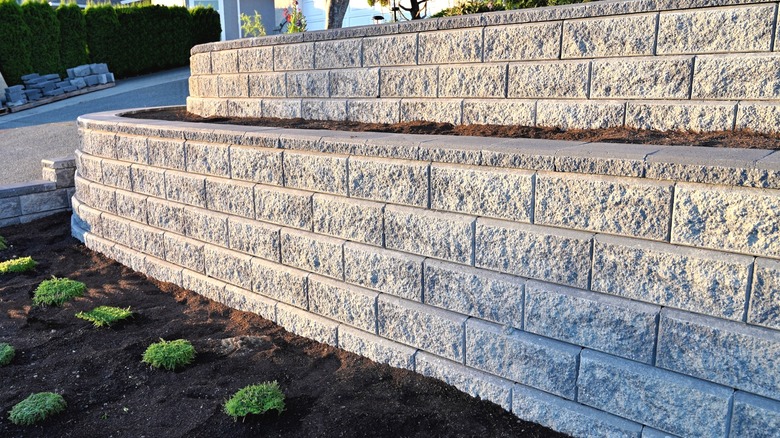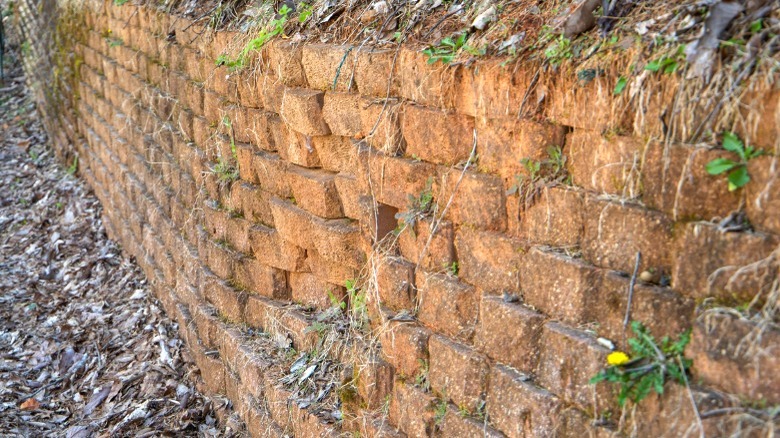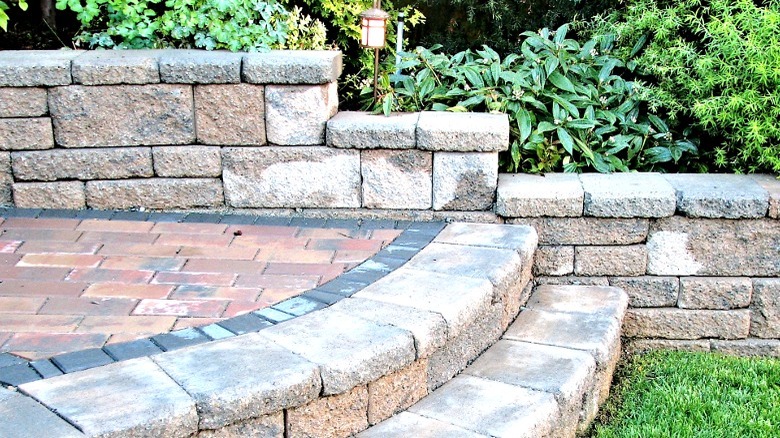Paver Wall Maintenance Tips You Can't Afford To Ignore
A well-formed retaining wall can certainly provide dependable stability, but it's easy to take it for granted and slack off on upkeep. Maintenance is an ongoing need to ensure your paver wall's looks and longevity. According to HomeGuide, the average cost of repairs can run over $200 and a new retaining wall can be over $4,000, so it pays to keep your build in shape. Any expenses involved in maintaining your wall are nominal, and it takes little time or effort to manage, making paver wall maintenance a no brainer.
Making your pavers last starts with assessing its structure, especially if you did a DIY retaining wall. Walls need adequate drainage backfill separated from the ground with a filter screen. A drainage pipe at the bottom prevents water from accumulating and putting pressure on the pavers. Beneath the wall is a footing that DIYers may not make wide, level, or stable enough to support the structure — a common mistake when making a paver wall. Consider consulting a professional if anything needs reworking or repairs. When you're confident your wall is in good condition, you only have to worry about maintaining it.
Top paver wall maintenance tips you need to know
If the structure is sound and the area drains properly, taking care of the wall is a simple task you can knock out about four times a year. Start with power washing and scrubbing to remove mold stains and efflorescence. You can then work on weeding. Any plants poking out under or between the pavers need removal. If left to grow behind the wall, they might expand and push against the wall to cause damage. If desired, you can also spray weed killer, but know these products are quite toxic. You can make a diluted dish soap and water mixture, or one with vinegar and water instead. With the latter, it's very important that you dilute it enough, as vinegar is too acidic on its own and may cause damage — aim for a 1:1 ratio of vinegar to water.
Salt and other deicers during the winter are also out. But you can help prevent ice buildup and many staining issues by applying a sealant to the wall. As you do all this cleaning and sealing of the wall, don't forget the plants around it. Healthy rooted plants offer soil support and drainage, so you'll want to resod and care for your covers as needed. Well-built retaining walls can last a lifetime with the proper upkeep, saving you tons of money in the long run. If you use the right methods for building your paver wall, maintenance steps like these are cheap, fast, and straightforward ways to ensure its long-term performance.
Paver wall issues to watch for
Watching for signs of damage is a crucial aspect of seasonal paver wall maintenance. Gaps and cracks may require paver replacements, and any leaning can indicate erosion or inadequate construction. Though these are issues you may be able to readily repair, you will probably fare best with an expert if the wall needs a rebuild. Bowing or bulging are equally cause for concern, as they might indicate an improper drainage issue. Similar issues can pop up when there's too much weight bearing down on your paver wall, like a newly constructed shed or a parked large vehicle. Nearby trees can also expand into the area and put extra pressure on the load.
Drainage plays a vital role in a retaining wall's performance. Any drainage channels around the wall should be clear and in good repair to stop water from accumulating. Some settling is normal, but you should check annually for any behind the wall that might require backfill to prevent pooling. Beyond that, monitor your wall's drainage after it rains or when the snow and ice from the winter melt. Fix water buildup around the wall, and clear any drain holes to keep the force against the wall from becoming too much for it to handle. You may have to install additional drainage around the property to stop excess water from flowing to the wall.


